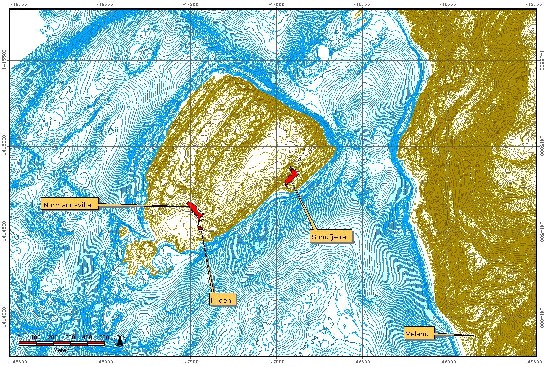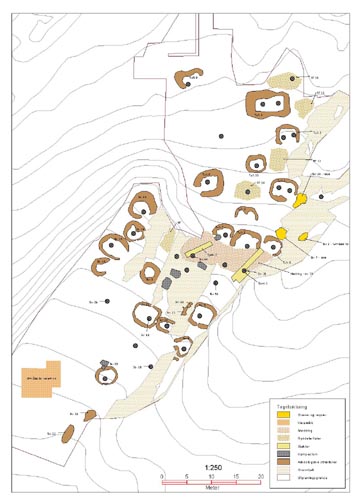|
The
excavations
The excavations
at Melkoya were completed September 13th. We are pleased
with the results after this year's season, which have
given us new and complementary knowledge of the prehistory
of Finnmark. The excavation of many different dwellings
and artifacts gives us a rich basis for the further
interpretation of past people's settlement in, and
usage of, this area.
Thousands of flakes and debitage
after the production of stone tools in different raw
materials, such as slate, quartz, quartzite, rock
crystal, chert and flint, were excavated. We have
found several artifacts from Late
Stone Age and Early
Metal Age, such as knives, arrowheads, scrapers,
axes and adzes, cores and awls. Artifacts of wood
or bone have not been found, but shards of ceramics
grained with asbestos appeared both in Sundfjaera
nedre and at Melandet.
The most spectacular findings are
the pearls
of amber. In a grave in Sundfjaera midtre several
pearls were found. Amber is very rare in Stone Age
Northern Norway, and these pearls originate from Denmark
or the Baltic.
Statoil is now in control of Melkoya,
and the construction of the gas plant is far progressed.
It is only a question of time before the last traces
of the people living at this island through thousands
of years will have to give way to gas and concrete.

Click the map
for a larger image
Excavated
structures
In Sundfjaera
a total of 20 dwellings were found. Several other
structures were excavated, such as possible gravemounds,
cleared areas, fireplaces, and cooking pits. During
the excavation of one of the mounds one pearl of amber
was found. Preservational conditions for organic material
are not good on Melkoya, therefore no skeleton, clothings
or wrappings were found.
Two so-called "hellegrop",
pits lined with flat stones, were found in Sundfjaera
nedre. These are oblong/rectangular pits, around
2-3 meters long and 1 meter wide, with a greasy layer
of ash and charcoal in the bottom. Probably these
were used for processing or boiling whale- and seal
blubber in the period between AD 200-1.200.
In prehistory the sealevel
has been higher than today. Since the settlements
have been located close to the shoreline, the oldest
are found higher in the terrain than the younger.
This reflects the gradual withdrawal of the sea after
the last ice age, 12.000 years ago. Accordingly, we
find the traces of settlement from Early
Stone Age (10.000-4.500 BC) in the top of Sundfjaera.
Further down we find dwellings from
Late Stone Age (4.500-1.800 BC), and towards the
present seashore we find settlement from Early
Metal Age (1.800BC-0) and Iron Age (0-AD 1.100).
Consequently, from top to bottom the finds from Sundfjaera
represent a history of settlement that span a period
of 8.000 years.
At Melandet,
across the Melkoya strait, several nicely preserved
artefacts also were found. This area is heavily influenced
by the construction of a tunell and road connecting
Melkoya to the mainland. Several demonstrations against
gas exploitation of the Arctic ocean have taken place,
amongst others with activists
chaining themselves to machines. Here an area of ca.
20 m2 was opened, and many single objects were found.
However, we could not find any structures like tent-
rings, dwellings or fireplaces.

The
work ahead
The
finds and documentation are now at Tromso Museum.
Here the finds first will be cleaned, then catalogued
according to type of artifact and rawmaterial. The
field supervisors will then start writing the reports
from their respective areas of excavation. These reports
will account for and describe the methods of excavation
and documentation. Further, the reports shall contain
a detailed description of the finds, and present an
interpretation of the material each field supervisor
was responsible for.
At the same time the scientific
samples are sent to different laboratories for analysis.
The charcoalsamples are cleaned before they are examined
to determine what species of three they originate
from, and thereafter they are sent to New Zealand
for radiocarbon dating. The pollen- and macrofossilsamples
are analyzed at the University of Tromsoe for information
about the relation between vegetational development
and settlement history during the last 10.000 years.
The phosphate- and susceptibilitysamples are analyzed
in Sweden. Through these we hope to gain some knowledge
about where organic material, such as waste, was deposited.
In the end all results are collected
and interpreted in one major publication. This is
to be ready by the end of 2004.
We will continously publish
results when they are available at this site.
|